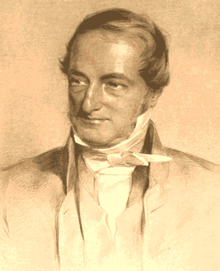William Daniel Conybeare
William Daniel Conybeare (born June 7, 1787 in London , † August 12, 1857 in Winchester (Itchen Stoke)) was a British geologist and paleontologist .
Live and act
Conybeare was born in London and educated at Christ Church College, Oxford . After joining a religious order, he held various church offices. He was also a founding member of the Bristol Philosophical Institution in 1822.
He became enthusiastic about geology after attending the lectures of John Kidd (1775-1851). After completing his studies, he made extensive trips to Great Britain and the continent, where he conducted geological studies. He was also one of the earliest members of the Geological Society of London . Both William Buckland and Adam Sedgwick pointed out how much they benefited from his knowledge of geology when they began to study the area.
The scientific description of a plesiosaur found by Mary Anning goes back to him and later investigations of this extinct genus of reptiles have confirmed him in all important points. Together with William Buckland, he published a thesis paper on the south-western coalfields of England, which was published in 1824. He also published scientific papers on the Thames Valley, on the theory of the mountain ranges by Léonce Élie de Beaumont, and on a landslide that occurred near Lyme Regis in 1839.
His main work is Outlines of the Geology of England and Wales , which appeared in 1822 and which he wrote together with the geologist William Phillips (1775-1828). This work was a major influence on the science of geology in Britain. Together with Phillips, he introduced carbon .
Conybeare was a member of the Royal Society and a corresponding member of the Institut de France . In 1844 he was awarded the Wollaston Medal of the Geological Society of London .
Web links
- Entry to Conybeare; William Daniel (1787-1857) in the Archives of the Royal Society , London
| personal data | |
|---|---|
| SURNAME | Conybeare, William Daniel |
| BRIEF DESCRIPTION | British geologist and paleontologist |
| DATE OF BIRTH | June 7, 1787 |
| PLACE OF BIRTH | London (United Kingdom) |
| DATE OF DEATH | August 12, 1857 |
| Place of death | Winchester (Itchen Stoke) |
